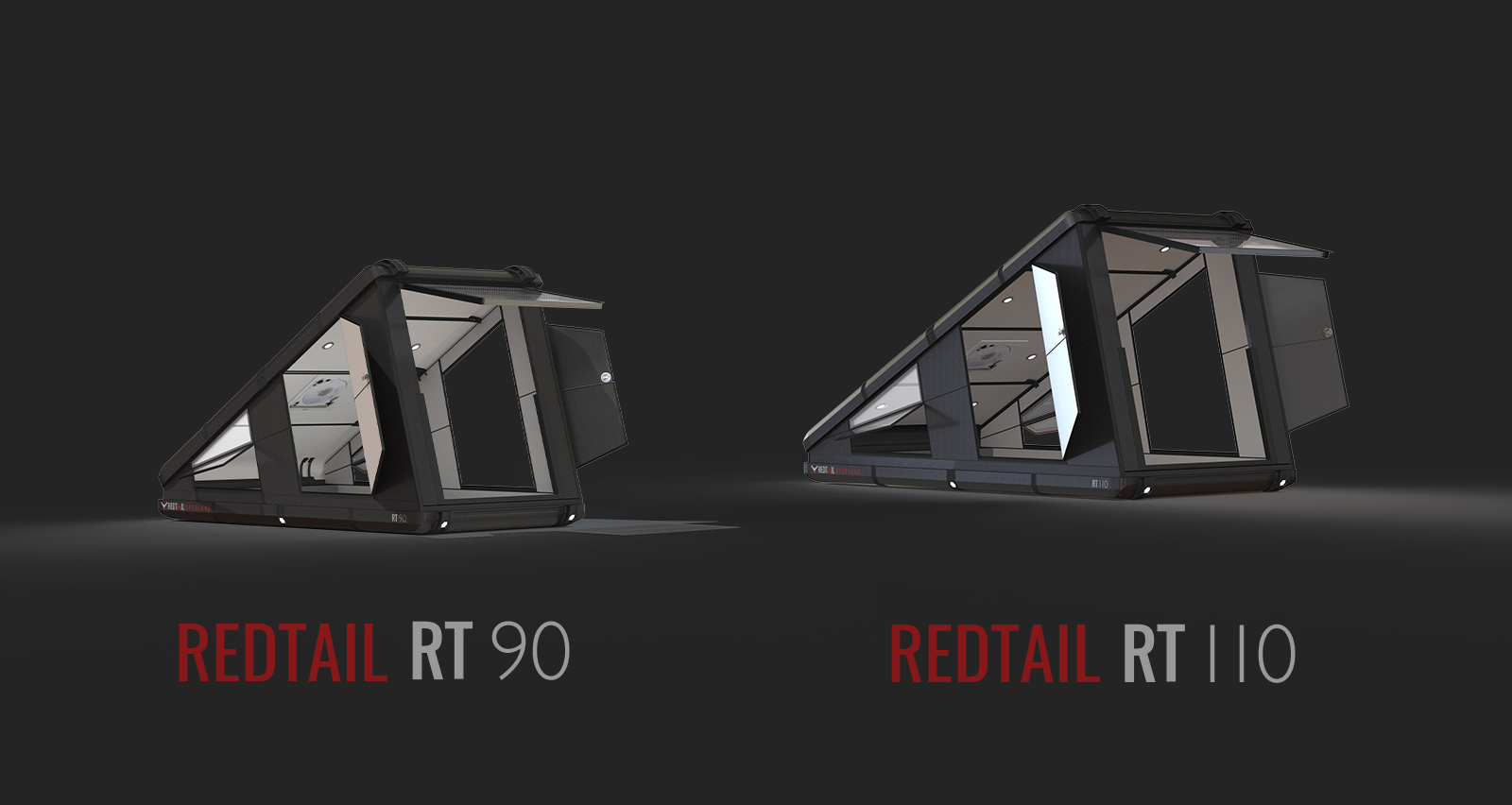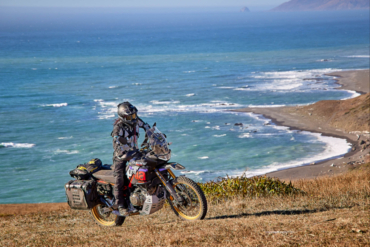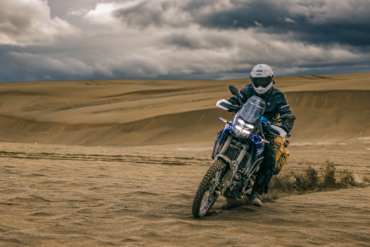Redtail Overland may have just created the ultimate vehicle rooftop bedroom.
Think of the Redtail Overland RT as a super-high-end rooftop camper (RTC). It’s basically a high-tech, carbon fiber, hard-sided rooftop tent with a full electrical system and heater. As a bonus, it offers access from the vehicle interior — if your vehicle has a sunroof, that is.
However, carbon fiber, machined aluminum, lithium batteries, a diesel heater, LED lighting, and more don’t come cheap! Initially, Redtail Overland will offer two models, the RT 90 and RT 110, which will cost $20,000 and $25,000, respectively. That’s a lot of adventure money!
“We took everything that is great about rooftop camping and enhanced it — adding heat, power, lighting, security, and next-level comfort,” the brand said. “We simplified the setup and breakdown process, making it easier to blaze more trail, and packaged everything in an elegant design we’re proud to keep on our vehicle year-round.”
Redtail Overland
Redtail Overland was founded in 2019 by Ty and Annie Tatro. The couple has more than 18 years of combined experience in the luxury overland industry, as they both worked at EarthRoamer until last year. For years they lived a double life, selling massive expensive luxury overland vehicles during the week and camping out of a basic rooftop tent on the weekends with their family.
These contrasting experiences sparked an idea. What if you could merge the high-end extravagant camping experience found in an EarthRoamer with the simplicity of rooftop tent camping? From this concept emerged the origami-like, carbon fiber wonder that is the Redtail Overland RTC.
Rooftop Camper (RTC)
The first question you have to ask yourself is why. Why offer hard sides instead of traditional soft tent material? The answer is four-fold.
The first reason, and the one you’ll appreciate every time you use this product, is the ease of setup and breakdown. Traditional soft-sided rooftop tents are pretty quick and easy to set up. When stowing them, however, they can take some work to make sure all the tent material is inside the shell.
This usually involves a lap or two around the vehicle tucking in the material. The hard-sided Redtail Overland RTC, on the other hand, instantly pops up and stows away without the fuss of tucking.
Another big drawback of traditional rooftop tents is the lack of insulation, which doesn’t necessarily make them ideal for four-season camping. The hard panels in the RTC, by contrast, have built-in insulation. This helps keep the cold out in the winter and the heat out in the summer.
Third, traditional rooftop tents can be noisy in windy conditions. Perched atop a vehicle and camped out in exposed areas, like the desert, the soft tent materials and zippers tend to flap in the breeze. This varies greatly from tent to tent, but it’s almost always an issue. If you park into the wind with the wedge shape of the Redtail Overland RTC, you should be able to get a restful night’s sleep protected inside its solid walls.
Finally, the hard-sided tent remains legal in grizzly country where tent camping isn’t allowed. This can also be true for campgrounds that don’t allow tent camping. It’s part of why Redtail Overland calls this a rooftop camper instead of a rooftop tent.
Redtail Overland Hard-Sided Rooftop Camper Features
Power
Besides the obvious high-quality materials and hard-sided walls, the Redtail Overland rooftop campers also offer up some other pretty features you don’t find in a traditional rooftop tent. Think full electrical system, diesel heater, access to the vehicle interior, integrated mounting solutions, full locked security, and more.
About that crazy, standalone electrical system in each RTC: The core of the system draws from solar on the roof and a lithium battery pack in the nose of the camper. You also get four exterior Baja Designs S1 area lights and fully dimmable LED interior lighting.
Controlling the whole system is a Switch Pros unit, which can also be controlled through a Bluetooth-enabled app on your phone. USB and 110-volt (through an inverter) outlets inside the camper power all your accessories and electronics. All this adds up to full functionality without any wiring to the vehicle or drain on your vehicle’s battery.
The other big luxury feature on this camper system is an integrated Webasto diesel heater unit. It’s built into the camper in the nose, alongside the battery pack. This particular diesel heater is rated to work well even at high altitude, up to 11,000 feet. The only real downside to the diesel heater is that you have to mount an external diesel tank somewhere or plumb a line into the tank on your diesel vehicle.
Accessibility
I, for one, like to travel in a camper that allows me to get to and from the driver’s seat of the vehicle without leaving the vehicle/living space. (Think van life — there’s a reason it’s so popular!) The Redtail RTC offers a hatch in the floor for just this purpose.
An expanding foam gasket seals off the area between the hatch in the floor of the tent and the sunroof on your vehicle. The only downside to this system is that if you wanted to drive away after a night’s sleep without exiting the vehicle, you’d have to leave the tent deployed, as it requires you to be outside to open and close.
Installation
Many people think they need to put their rooftop tents atop a full roof rack. All this does is add unnecessary height to the tent and weight to the top of your vehicle. Usually, all that is needed are a few crossbars. With the RTC, the crossbars are integrated into the structure of the camper, so no bars or rack are required.
Redtail will offer proprietary feet/towers that will connect the T-Track in the tent bottom to the vehicle roof. These feet will be lockable for security but also have a quick-release pin for easy removal.
Foot Room
Traditional wedge-style rooftop tents tend to have very little foot room. This is an issue for someone like me that is tall and has big feet, as it wakes me up when I roll over in my sleep and my feet are restricted by the roof.
Unlike a traditional hinge, the front hinge on the Redtail Overland RTC actually slides up about 3 inches. This helps give you vertical room for your feet and a more spacious feel to the tent. It’s not as much space as a full pop-top would offer, however.
How to Buy the Redtail Overland RTC
Redtail Overland will first offer two versions of its RTC product: the bigger Redtail RT 110 and the smaller Redtail RT 90.
The Redtail RT 110 will set you back $25,000, install included. It offers a 60Ah lithium battery pack, with 330 W of solar, in a 250-pound package. The exterior closed dimensions are 110 x 60 x 10 inches.
The Redtail RT 90 will set you back $20,000, install included. It offers a 40Ah lithium battery pack, with 210 W of solar, in a 190-pound package. The exterior closed dimensions are 90 x 56 x 10 inches.
Redtail Overland just recently leased a shop in Longmont, Colorado, where the brand is finishing up its first production-quality prototype in the next 2 months. You can preorder a Redtail RTC today. It takes a 10% deposit to get your spot in line.
Production is scheduled to start at the end of August, with a 4- to 6-week lead time to start with once production gets going. There are already several preorders in the queue, however, so the earliest delivery slots currently available are in December 2020.
Pros
- Hard-sided camper
- Super easy and quick setup and breakdown
- Can go where traditional RTTs can’t (bear country and hard-side-required campsites)
- Quiet in the wind
- Four-season comfort (insulated & heated)
- Fully integrated, self-contained electrical system (solar, lithium batteries, inverter, etc.)
- Vehicle access from inside the tent, and vice versa
- Lockable in both closed and open positions
- No roof rack or crossbars required
- Interior and exterior LED lighting
- Roof bent/Fan ventilation
- Full 80″ long mattress
- 3-year warranty
Cons
- Expensive
- Heavy
- Not a full pop, just a wedge-style pop-top
- Diesel heater requires an external diesel fuel source
- Waitlist to purchase
Future Products
Don’t expect Redtail Overland to be an RTC-only company for very long. Its founders have all sorts of ideas about how to bring high-tech and luxury overland vehicle features into more basic and nimble products for the adventurer.
The brand said, ” We plan to integrate our proprietary hinged wall and window system into future platforms.” It’s also thinking about complementary systems to the RTC product, like camp kitchens and the like, which would offer all the amenities traditional campers have.
The RTC is not just a camper, but a high-end experience in which every detail matters and serves a thoughtful purpose. It’s designed to be used as a vehicle for our customers to pursue their outdoor passions and intended to enhance their experience, not hinder it with the hassles of traditional camping setups. We’ve worked hard to design a product that is intuitive, functional, easy and inspiring, and believe our customers will find more joy while camping, and venture out farther and more often because of it.
For more information or to place your preorder, be sure to check out RedtailOverland.com.












